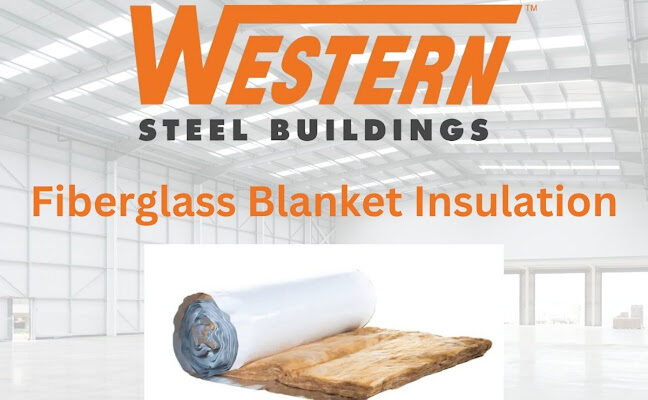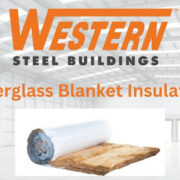Fiberglass insulation plays a crucial role in improving energy efficiency, temperature control, and soundproofing in metal buildings. Whether you are constructing a commercial warehouse, an agricultural barn, or an industrial facility, ensuring proper insulation is vital. Western Steel Buildings offers high-quality fiberglass blanket insulation designed for superior performance in various applications.
This article explores the importance of fiberglass insulation in metal building insulation, its benefits, R-values, and installation methods.
Understanding Fiberglass Blanket Insulation
Fiberglass blanket insulation, commonly referred to as Metal Building Insulation (MBI), is a popular choice for insulating metal structures. This type of insulation is available in different forms, including faced and unfaced options. It can be applied in various areas of a building, such as roof purlins, purlin cavities, girts, and wall panels. The use of fiberglass insulation enhances the building’s thermal efficiency, reduces energy consumption, and improves indoor comfort.
Common Nicknames for Fiberglass Blanket Insulation
- MBI (Metal Building Insulation)
- Roll insulation
- Batt insulation
- Bag insulation
- Sag insulation
- Cavity fill insulation
Benefits of Fiberglass Blanket Insulation
Fiberglass insulation offers numerous advantages, making it a preferred choice for metal building insulation:
- Energy Efficiency – Reduces heat transfer, lowering heating and cooling costs.
- Moisture Resistance – Faced fiberglass insulation provides an added vapor barrier to minimize condensation.
- Sound Absorption – Helps reduce noise levels inside metal buildings.
- Lightweight & Easy Installation – Can be installed quickly, making it a cost-effective solution.
- Versatile Applications – Suitable for both walls and roofing insulation.
- Durability – Maintains effectiveness over time, providing long-term energy savings.
R-Values of Fiberglass Blanket Insulation
The effectiveness of insulation is measured in R-values, which indicate the material’s resistance to heat flow. The higher the R-value, the better the insulation. Fiberglass insulation used in metal buildings is available in a wide range of R-values, including:
- R-10
- R-11
- R-13
- R-16
- R-19
- R-25
- R-30
- R-38
- Combinations of these values
The appropriate R-value depends on factors such as climate, building usage, and local energy codes.
Installation Areas for Fiberglass Blanket Insulation
1. Roof Insulation
- Installed over the roof purlins or in the purlin cavity.
- Helps regulate indoor temperature by minimizing heat gain and loss.
2. Wall Insulation
- Placed between girts and the wall panel or in the girt cavity.
- Provides additional thermal resistance and soundproofing.
3. Liner System Application
- Unfaced fiberglass insulation can be used above a liner system or as a secondary layer above laminated insulation.
- Enhances building performance and comfort.
Factors to Consider When Choosing Fiberglass Insulation for Metal Buildings
When selecting fiberglass insulation for metal building insulation, it is important to consider the following:
- Climate Zone: Areas with extreme temperatures require higher R-values.
- Building Usage: Insulation needs may vary for warehouses, manufacturing plants, or residential metal structures.
- Energy Code Compliance: Some regions have specific energy code requirements that dictate minimum R-values for insulation.
- Vapor Barrier Needs: Faced insulation with a vapor barrier helps control moisture buildup inside metal buildings.
Conclusion
Fiberglass insulation is an essential component of metal building insulation, offering benefits such as energy efficiency, soundproofing, and moisture resistance. Western Steel Buildings provides high-quality fiberglass blanket insulation in multiple R-values, ensuring optimal thermal performance for various applications. By selecting the right insulation type and R-value, you can enhance the comfort and durability of your metal structure while reducing energy costs over time.





Comments